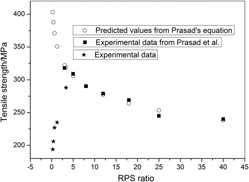Crossref Citations
This article has been cited by the following publications. This list is generated based on data provided by
Crossref.
Alaneme, Kenneth Kanayo
Adewale, Tolulope Moyosore
and
Olubambi, Peter Apata
2014.
Corrosion and wear behaviour of Al–Mg–Si alloy matrix hybrid composites reinforced with rice husk ash and silicon carbide.
Journal of Materials Research and Technology,
Vol. 3,
Issue. 1,
p.
9.
Yin, Jinwei
Zeng, Yuping
Yao, Dongxu
Xia, Yongfeng
and
Zuo, Kaihui
2014.
Enhanced properties of Cu/Sn alloy matrix composites reinforced with β-silicon nitride whiskers.
Journal of Materials Research,
Vol. 29,
Issue. 6,
p.
770.
Kumar, T. Satish
Subramanian, R.
Shalini, S.
and
Angelo, P. C.
2015.
Microstructure, mechanical properties and corrosion behaviour of Al–Si–Mg alloy matrix/zircon and alumina hybrid composite.
Forschung im Ingenieurwesen,
Vol. 79,
Issue. 3-4,
p.
123.
Cao, Xinjian
Jin, Jianfeng
Zhang, Yuebo
and
Zong, Bernie Yaping
2015.
Mechanical properties of iron matrix composites reinforced by copper-coated hybrid ceramic particles.
Journal of Materials Research,
Vol. 30,
Issue. 15,
p.
2360.
Liu, Yuan
Li, Wenjun
Wu, Gaohui
and
Jiang, Daming
2016.
The quench sensitivity of SiCp/2024Al composites based on Jominy end quench test.
Journal of Materials Research,
Vol. 31,
Issue. 9,
p.
1237.
Geng, Jiwei
Hong, Tianran
Ma, Yu
Wang, Mingliang
Chen, Dong
Ma, Naiheng
and
Wang, Haowei
2016.
The solution treatment of in-situ sub-micron TiB2/2024 Al composite.
Materials & Design,
Vol. 98,
Issue. ,
p.
186.
Khan, Mahmood
Amjad, Maham
Khan, Ansa
Ud-Din, Rafi
Ahmad, Iftikhar
and
Subhani, Tayyab
2017.
Microstructural evolution, mechanical profile, and fracture morphology of aluminum matrix composites containing graphene nanoplatelets.
Journal of Materials Research,
Vol. 32,
Issue. 11,
p.
2055.
Zhanwei, Yuan
Fuguo, Li
and
Chunwei, Wang
2017.
Study on the Hot Workability of SiCp/Al Composites Based on a Critical Strain Map.
Journal of Materials Engineering and Performance,
Vol. 26,
Issue. 9,
p.
4197.
Mao, Xuezhi
Hong, Yu
Wang, Binhao
Liu, Junwu
Zhang, Yujun
Feng, Dong
Yang, Lei
Shi, Changdong
Wu, Yucheng
and
Tang, Wenming
2018.
Fabrication, microstructures and properties of 50 vol.-% SiCp/6061Al composites via a pressureless sintering technique.
Powder Metallurgy,
Vol. 61,
Issue. 1,
p.
1.
Yinqiu Huang
Chen, Guohong
Wang, Binhao
Zhang, Jianhua
and
Tang, Wenming
2019.
Fabrication, Microstructure and Properties of the Mid-Fraction SiC Particles/6061Al Composites Using an Optimized Powder Metallurgy Technique.
Russian Journal of Non-Ferrous Metals,
Vol. 60,
Issue. 3,
p.
312.
Sun, Jian
Chen, Guohong
Wang, Binhao
Chen, Guodong
and
Tang, Wenming
2019.
Fabrication, Microstructures, and Properties of 50 vol.% SiCp/6061Al Composites via Hot Pressing.
Journal of Materials Engineering and Performance,
Vol. 28,
Issue. 5,
p.
2697.
Ashok Kumar, R
Akash, S J
Arunkumar, S
Balaji, V
Balamurugan, M
and
Jeevan Kumar, A
2020.
Fabrication and Corrosion Behaviour of Aluminium Metal Matrix Composites – A Review.
IOP Conference Series: Materials Science and Engineering,
Vol. 923,
Issue. 1,
p.
012056.
Kang, Pengchao
Zhao, Qiqi
Guo, Shiqi
Xue, Wei
Liu, Hao
Chao, Zhenlong
Jiang, Longtao
and
Wu, Gaohui
2021.
Optimisation of the spark plasma sintering process for high volume fraction SiCp/Al composites by orthogonal experimental design.
Ceramics International,
Vol. 47,
Issue. 3,
p.
3816.
Khan, Afnan Haider
Shah, Syed Ahmad Ali
Umar, Farheen
Noor, Uneeb
Gul, Rizwan Mahmood
Giasin, Khaled
and
Aamir, Muhammad
2022.
Investigating the Microstructural and Mechanical Properties of Novel Ternary Reinforced AA7075 Hybrid Metal Matrix Composite.
Materials,
Vol. 15,
Issue. 15,
p.
5303.
Laghari, Rashid Ali
Jamil, Muhammad
Laghari, Asif Ali
Khan, Aqib Mashood
Akhtar, Syed Sohail
and
Mekid, Samir
2023.
A critical review on tool wear mechanism and surface integrity aspects of SiCp/Al MMCs during turning: prospects and challenges.
The International Journal of Advanced Manufacturing Technology,
Vol. 126,
Issue. 7-8,
p.
2825.
Rativa-Parada, Wilson
and
Nilufar, Sabrina
2024.
Influence of Heat Treatment on Microstructure, Mechanical Properties, and Damping Behavior of 2024 Aluminum Matrix Composites Reinforced by Carbon Nanoparticles.
Nanomaterials,
Vol. 14,
Issue. 16,
p.
1342.
Chen, Y.T.
Zhu, S.Z.
Luo, H.J.
Wang, D.
Xiao, B.L.
and
Ma, Z.Y.
2024.
Effects of solution temperatures on microstructures and mechanical properties of B4C/7A04Al composites: A comparison study with 7A04Al alloys.
Materials Science and Engineering: A,
Vol. 890,
Issue. ,
p.
145899.



